3 Injury Prevention Exercises For The Lower Leg
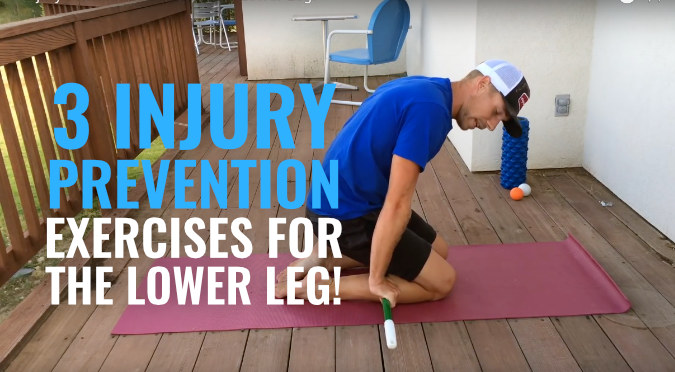
At The Run Experience, we’re always coming up with new injury prevention exercises for YOU, our runners! In this post, we take a look at some of Coach Kirk’s favorite injury prevention exercises for runners.
Why Are Injury Prevention Exercises So Crucial To Your Training?

Just like the car that you depend on to operate properly day in and day out, your running body needs REGULAR maintenance.
When either of these breaks down, chances are that some preemptive investigation could’ve helped us avoid the setback altogether.
We believe in getting your injuries BEFORE they get you. Using 5-7 minutes of your day to help prevent months of injury/recovery/time on the couch is ALWAYS worth it.
Injury Prevention Exercises: The Broomstick Bash!
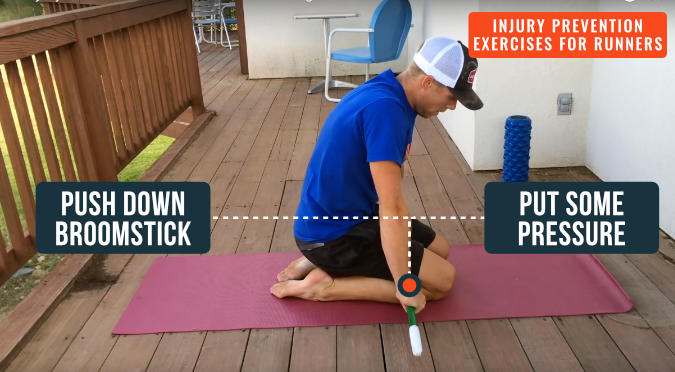
The best part about all of our injury prevention exercises is that you can do them at home with easy to find objects! And the same goes for our calf strengthening exercises.
So take a minute and go grab a broomstick.
Don’t worry, we’ll explain further 🙂
Got it?
We’re going to use it to get deep into our calf (and soleus specifcally) because I think we can all agree how these calves get tight during and after a run.
Here’s how the broomstick bash works:
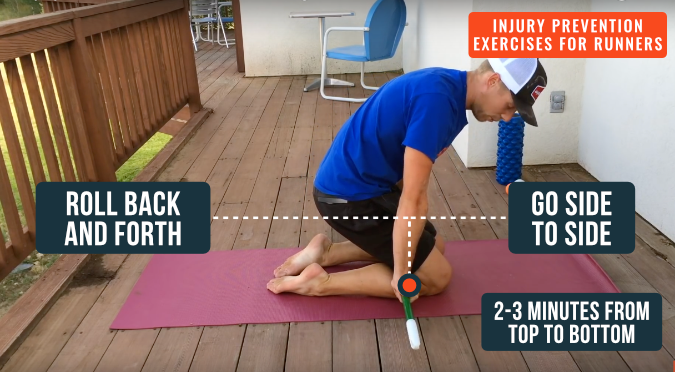
- Find a kneeling position on the ground. Butt sits back on the heels.
- Now you’re going to sandwich the broomstick between your hamstrings and calves.
- From here you’re going to start using the stick like a rolling pin.
- Use your arms to apply as much pressure as you’re comfortable with.
- Start just below the knee and work your way down to the top of the achilles.
- Alternate between rolling the broomstick forward/backward and making a “sawing” motion side-to-side when you get to a particularly tight spot.
- Spend about 2-3 minutes working down the length of the calves.
Why do we love this one so much?
As runners, we take the brute of our daily workouts in our legs. And more specifically, in our lower legs.
Our achilles’ tendons always seem to be the most tender, but the reality here is that the problem starts with the top of the chain, the calf.
Regularly taking care of these muscles will help to lengthen and calm the impact on the achilles’ tendons.
Give it a go!
Injury Prevention Exercises: The Inversion/Eversion Sandwich!
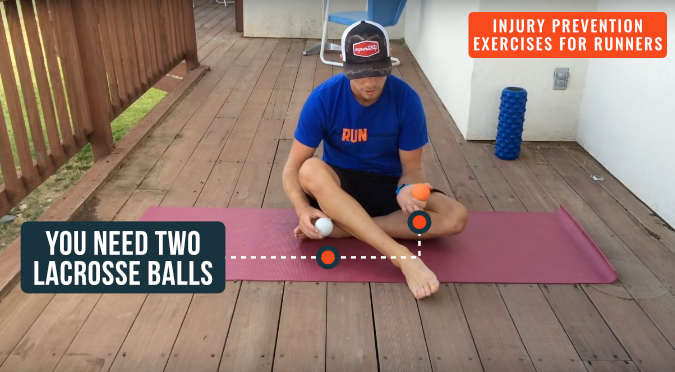
All you’ll need for this one is a pair of lacrosse balls or 2 balls of similar size and density.
We’re going to use them to get after your peroneals and the posterior side of your tibia (shin).
These muscles control your footstrike, pronation, supination, basically how and why your foot hits the ground the way it does.
Like the calves, they get tight QUICK!
Here’s how the inversion/eversion sandwich works:
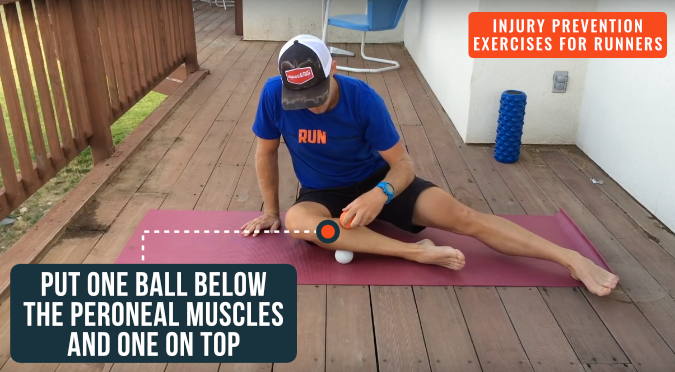
- Have a seat on the ground, with one leg bent “indian style” in front of you.
- Place one lacrosse ball under the side of the shin closest to the ground.
- Place the other lacrosse ball on the other side of the shin, creating a “sandwich” of the lacrosse ball, shin, lacrosse ball.
- From here you’ll use your hands to apply pressure, just to the ball on top of the shin.
- Once you’ve found a level of pressure you can deal with, begin to circle the ankle.
- Also try flexing and pointing the foot, switching circle direction, etc.
- Work up and down the shin, using this same technique, and spending more time on tighter areas.
- Spend 2-3 minutes on each leg.
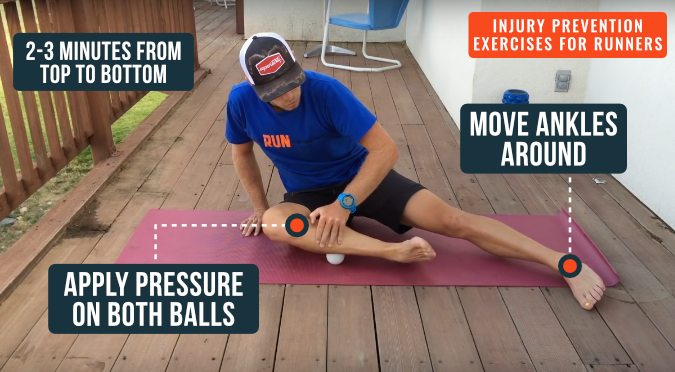
Injury Prevention Exercises: The Loaded Plantar Flex!
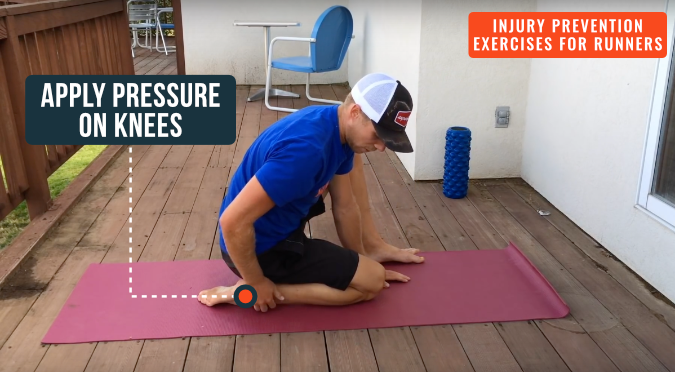
The last of our injury prevention exercises for the lower leg requires NO equipment at all!
We’re going to show you how to get into those ankles and the anterior side of the tibia.
As runners, we spend a lot of time with our toes flexed up toward us. Each step we take is made possible by the tiny muscles at the front of our ankles and shins.
You’ve probably felt how tender these guys can get.
So let’s get in there!
Here’s how the loaded plantar flex works:
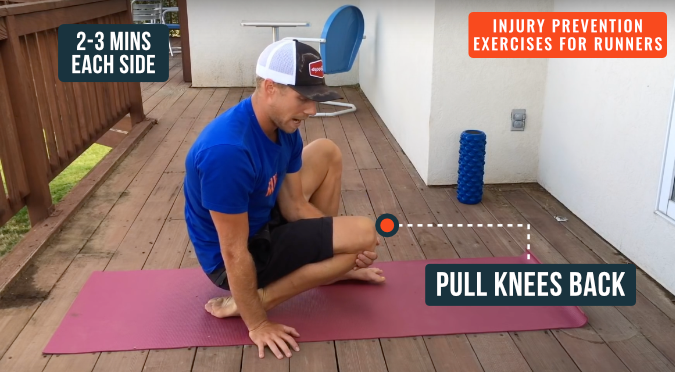
- Like the broomstick bash, you’re going to find a kneeling position, with your butt seated back on your heels.
- The difference this time is that one foot will be stepped out and planted under your hips as if you were about to stand up from the kneeling position.
- Our focus will be on the leg still knelt against the ground.
- Even in the kneeling position, you should be feeling some sort of stretch down the front of the ankle.
- Now put your hands on the kneeling knee and lift it slightly off the ground.
- Make small waves forward and back, lifting the knee higher and higher off the ground.
- You can lean your upper body back to counter the shifts and balance yourself.
- The stretch will become more intense, the higher the knee lifts off the ground.
- Spend 2-3 minutes on each side, moving through small and larger ranges of motion, to address all areas of the front of the ankle and anterior tibia.
There’s no doubt about it…these injury prevention exercises WORK!
Make sure to include them in your running workout plan and modify these as you need, if the pressure or pain is too much. But like anything else mobility, the more often you do it, the easier and more enjoyable it becomes!
For sticking with us, enjoy a FREE injury prevention video series. We give you some of our favorite tools and tricks for keeping your body healthy for the most enjoyable running possible! Get yours here.
